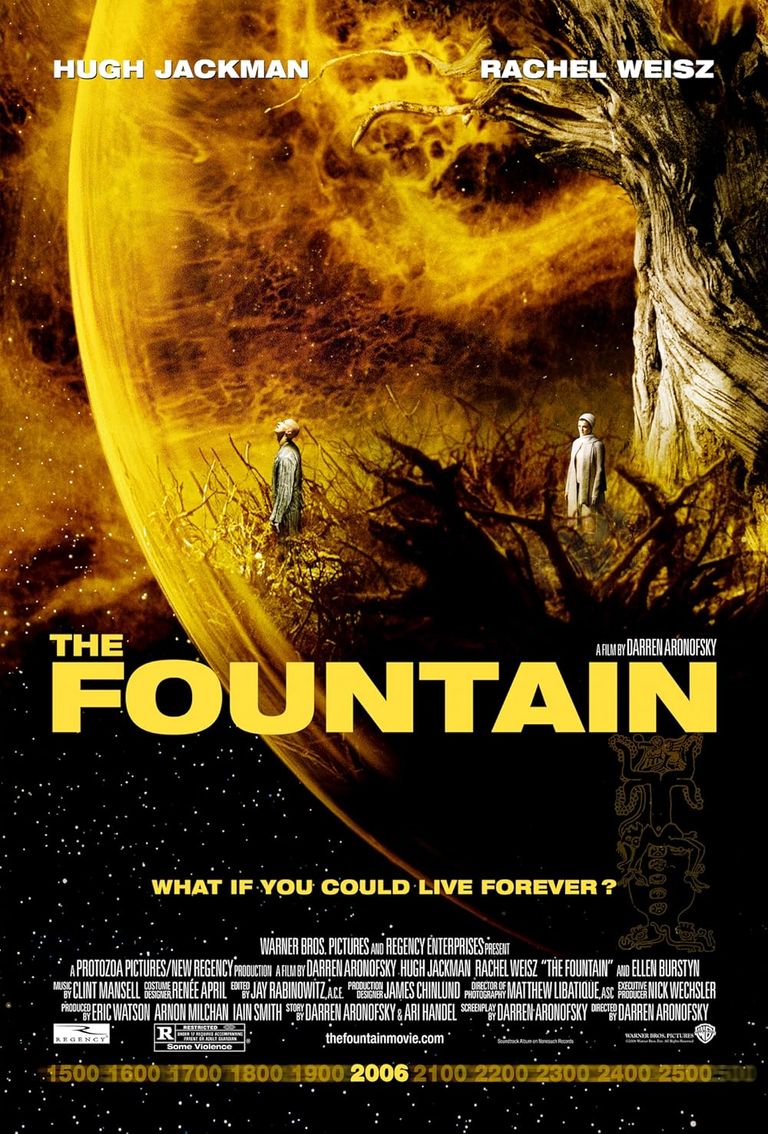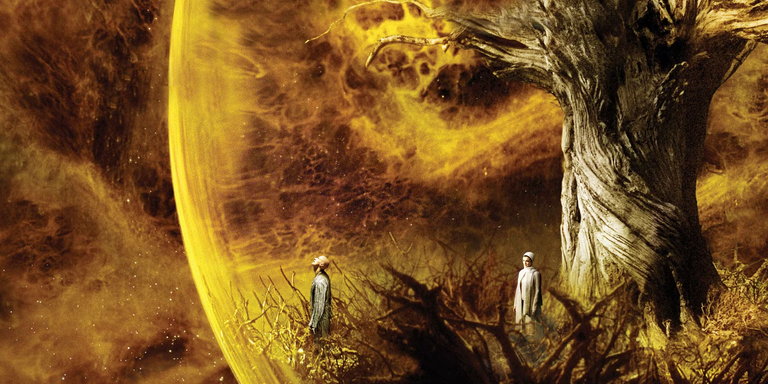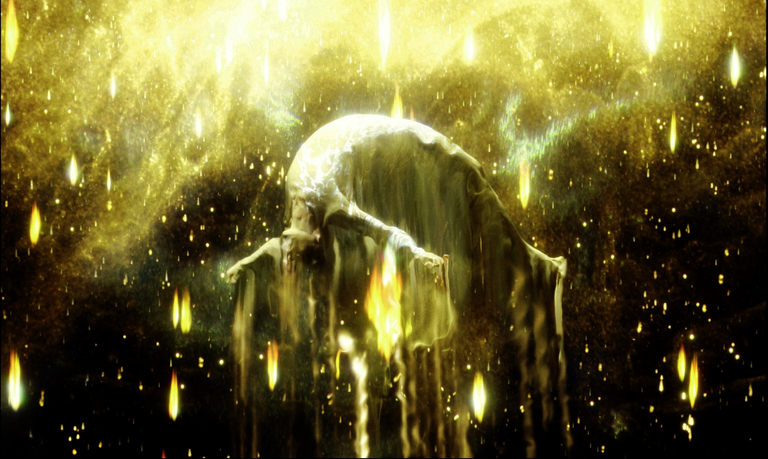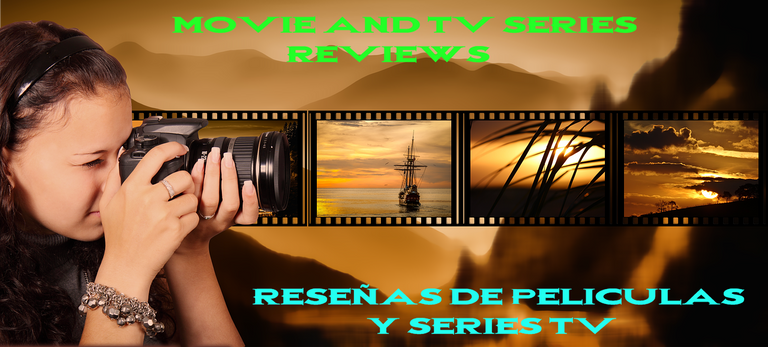
The Fountain is a 2006 film directed by Darren Aronofsky , presented in competition at the 63rd Venice International Film Festival.
Tomas Creo is a researcher at a brain cancer clinic. His research has a universal motivation for medicine, but also a personal one: he is burdened by the responsibility towards his sick wife for whom Tomas fights day and night with great love in an attempt to find a cure.
In constant struggle and relationship with the theme of death, the story mixes reality and psychedelic fantasy, making the epic tale written by his wife, the scientist's rational ego and harsh reality clash in an almost specular way.
In a context where the main plot gradually loses importance as the story progresses, the only character of the protagonist slowly splits into three to face his challenges and reunite into one soon after.
The romantic conquistador, born from his wife's book, ready to sacrifice everything and everyone to save his beloved; the zealous monk who, mortifying the body in favor of the soul, dedicates himself with Carthusian patience to his work and the man who must face things bigger than himself every day, face and confront each other in the shadow of the Tree of Life: the mythical plant opposed to the Tree of Knowledge, of which Western and Mayan religious traditions narrate and which constitutes, at the same time, the victory and the surrender in the face of death.
Above them Xibalba, dying star and realm of the dead, where life reaches its minimum and immediately after its maximum in a continuous regeneration.
In 2001, Darren Aronofsky proposed to Warner Bros. and Village Roadshow to finance his new film, based on his original story. Initially, the film was written to make Brad Pitt the main actor of the entire screening. In June 2002, however, the American production company contacted the director himself, telling him that the continuing costs of the film did not allow the production to proceed with the project; the only alternative left to Warner Bros. was to wait for the arrival of another financier to proceed with the production of the film.
Eric Watson, co-producer of the project, took an interest in spreading the news of the film's development also within the circuit of smaller production houses, winning over New Regency, which filled the gap created by Village Roadhsow's disinterest in the project.
The film's development ended in October 2002 with a budget of $70 million thanks to double financing from Warner Bros and New Regency but the start date of filming began to slip due to continuous cancellations by the actors: Brad Pitt initially did not want to participate in the production of the film because in that same period the filming of Troy was starting and therefore he abandoned the project even if he was sorry, Russell Crowe was then contacted but he also declined the project to take part in Master and Commander; precisely because of these continuous delays in the start of filming Warner Bros decides to suspend the development of the film and therefore fires all the actors hired.
In February 2004, Warner Bros. decides to take advantage of the work done up to that point and therefore calls Darren Aronofsky again to finish the work done up to that point, but the budget will be only $ 35,000,000, and given the continuous defections by the actors chosen by the artistic production, it will be Warner Bros. to choose the main actor; Hugh Jackman thus begins to study the part of the protagonist of the film and proposes Rachel Weisz as the female protagonist of the screening.
Both actors have never had previous experiences with the director, but they are very interested in the project, so much so that they employ many personal resources to best interpret the situations presented in the film.
For example, Hugh Jackman takes Tai Chi lessons for 14 months to be able to reach the Lotus Position proposed several times in the film; instead, Rachel Weisz focuses on the experiences of terminally ill cancer patients, often the actress herself will struggle to manage the emotions that the story will force her to bear, as she herself admits.

La Fuente de la Vida es una película de 2006 dirigida por Darren Aronofsky , presentada en competición en el 63º Festival Internacional de Cine de Venecia.
Tomás Creo es investigador en una clínica de estudios de cáncer de cerebro. Su investigación tiene una motivación médica universal, pero también personal: está abrumado por la responsabilidad hacia su esposa enferma, por quien Tomas lucha día y noche con gran amor en un intento de encontrar una cura.
En constante lucha y relación con el tema de la muerte, la historia mezcla realidad y fantasía psicodélica, haciendo que la historia épica escrita por su esposa, el ego racional del científico y la dura realidad choquen casi como un espejo.
En un contexto donde la trama principal pierde importancia a medida que avanza la historia, el único personaje del protagonista se divide lentamente en tres para afrontar sus desafíos y reunirse en uno inmediatamente después.
El conquistador romántico, nacido del libro de su esposa, dispuesto a sacrificarlo todo y a todos para salvar a su amada; el monje celoso que, mortificando el cuerpo en favor del alma, se dedica con esmerada paciencia a su trabajo y el hombre que cada día tiene que afrontar cosas más grandes que él, enfrentarse y compararse a la sombra del Árbol de la Vida. : la planta mítica opuesta al Árbol del Conocimiento, de la que hablan las tradiciones religiosas occidentales y mayas y que constituye, al mismo tiempo, victoria y rendición ante la muerte.
Sobre ellos Xibalbá, estrella moribunda y reino de los muertos, donde la vida alcanza su mínimo e inmediatamente después su máximo en una continua regeneración.
En 2001, Darren Aronofsky propuso a Warner Bros y Village Roadshow financiar su nueva película, basada en su historia original. La película fue escrita inicialmente para convertir a Brad Pitt en el actor principal de toda la proyección. En junio de 2002, sin embargo, la productora estadounidense se puso en contacto con el propio director y le dijo que los costes continuos de la película no permitían que la producción continuara con el proyecto; La única alternativa que le quedaba a Warner Bros era esperar la llegada de otro financiero para continuar con la producción de la película.
Eric Watson, coproductor del proyecto, se interesó así en difundir la evolución de la película también en el circuito de las productoras menores, conquistando New Regency, que colmó el vacío creado por el desinterés de Village por el proyecto Roadhsow.
El desarrollo de la película finalizó en octubre de 2002 con un presupuesto de 70 millones de dólares gracias a la doble financiación de Warner Bros y New Regency pero la fecha de inicio del rodaje empezó a retrasarse debido a las continuas negativas de los actores: Brad Pitt inicialmente no quería participar en la producción de la película porque en ese mismo período comenzaba el rodaje de Troy y por eso abandonó el proyecto aunque lo lamentó, se contactó con Russell Crowe pero él también rechazó el proyecto para participar en Master. y Comandante; Precisamente por estos continuos retrasos en el inicio del rodaje, Warner Bros decide suspender el desarrollo de la película y por tanto despide a todos los actores contratados.
En febrero de 2004, Warner Bros decide explotar el trabajo realizado hasta ese momento y por eso llama nuevamente a Darren Aronofsky para terminar el trabajo realizado hasta entonces, pero el presupuesto será sólo de 35.000.000 de dólares, y dadas las continuas deserciones por parte de la actores elegidos por la producción artística, Warner Bros elegirá al actor principal; Hugh Jackman comienza así a estudiar el papel de la protagonista de la película y propone a Rachel Weisz como protagonista femenina de la proyección.
Ambos actores nunca han tenido experiencia previa con el director, pero se muestran muy interesados en el proyecto, hasta el punto de que utilizan muchos recursos personales para interpretar mejor las situaciones que se presentan en la película.
Hugh Jackman, por ejemplo, tomó lecciones de Tai Chi durante 14 meses para poder alcanzar la Posición de Loto propuesta varias veces en la película; en cambio, Rachel Weisz se centra en las experiencias de pacientes con cáncer terminal; a menudo, la propia actriz tendrá dificultades para gestionar las emociones que la historia la llevará a soportar, según ella misma admite.
Special effects. / Efectos especiales.

The film features numerous special effects, especially by Jeremy Dawson and Dan Schrecker, who give credit to the completeness of the projection, especially because they manage to perfectly convey the sense of immensity and infinity that pervades a good part of the images proposed within the film. To best convey the idea that Darren Aronofsky wanted to express, they watched Stanley Kubrick's 2001: A Space Odyssey several times, trying to reproduce the same sensations reported within the film.
The film grossed a total of nearly $16,000,000, more than double the director's previous work, Requiem for a Dream. However, having cost more than double ($35,000,000) it proved to be a clear flop at the box office.

La película cuenta con numerosos efectos especiales, especialmente de Jeremy Dawson y Dan Schrecker, que acreditan la exhaustividad de la proyección, sobre todo porque consiguen transmitir a la perfección la sensación de inmensidad e infinito que impregna buena parte de las imágenes propuestas dentro de la película. película. Para transmitir mejor la idea que Darren Aronofsky quería expresar, vieron varias veces 2001: Odisea en el espacio, de Stanley Kubrick, intentando reproducir las mismas sensaciones relatadas en la película.
La película recaudó un total de casi 16.000.000 de dólares, más del doble que el trabajo anterior del director, Réquiem por un sueño. Sin embargo, después de haber costado más del doble (35.000.000 de dólares), resultó ser un evidente fracaso de taquilla.

Thanks for reading!!! / Gracias por leer.
Fuentes de los separadores de texto / Source divider text:

